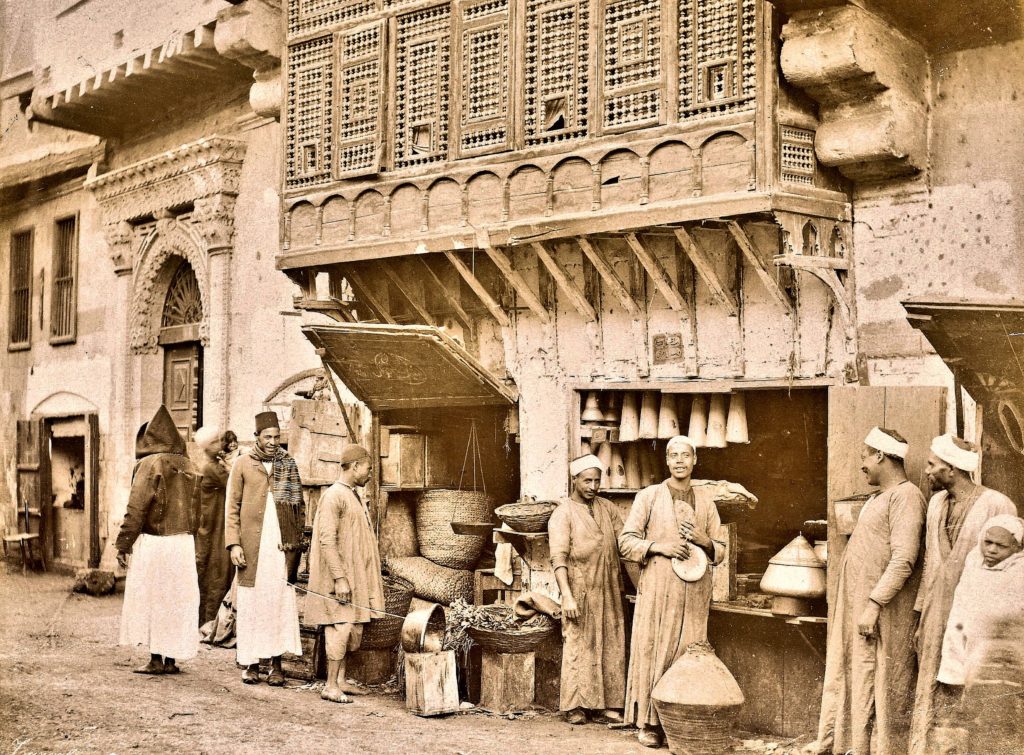Wood Culture and Timber Houses

Food Stores in Cairo, 1880s, from “Views of Turkey, Egypt and India”; Pierre de Gigord, collector; album compiled 1890. Getty Research Institute.
Cut stone, marble and brick are the building blocks for monumental religious architecture, city walls and fortifications, palaces and great civic buildings, and provide a powerful visual link to the past. There is, however, also a strong tradition of architecture which makes use of one of a far more practical and curiously durable material, and one which endows those same urban centres with access to a different, more intimate history. That material is wood.
The sheer variety of construction is enormous, from the UNESCO-listed thirteenth century Great Mosque at Sivrihisar with its timber ceiling and internal wooden pillars, to the early twentieth century pavilion on the Asian side of Istanbul’s Bosphorus which served as the summer residence and painting studio of Abdülmecid, the Ottoman heir presumptive and last Caliph, forced into exile in 1924. The last great Ottoman Sultan, Abdülhamid II, was himself an accomplished carpenter and his palace workshop produced in only three weeks an elegant pre-fabricated bungalow which was used as a pavilion for Kaiser Wilhelm when he toured the silk carpet factories in Hereke in 1894.
Most rightly associate wood not with these royal structures but the more modest vernacular houses, the setting for everyday life in the Ottoman Empire. Preserving the fabric of those few neighbourhoods where there are still wooden buildings has long been a priority in Turkey and there is an extensive raft of legislation to protect listed historical buildings. Construction in wood represents not just an important aesthetic which helped define Ottoman urban life, but embodies a great deal of practical knowledge that in a country with Turkey’s seismic history, could actually promote both safer and more environmentally sensitive housing.
Wood was clearly the material of choice before the First World War in Turkey, its popularity only affected by cost. Even the substantial merchant homes in the picturesque town of Safronbolu are half-timber (himis) with the space between wood supports in-filled with stone rubble and then covered in a lime plaster. Drawings from the seventeenth century show similar houses in Istanbul. The lime-plastered rubble facades were vulnerable to salt and sea air and the so the sea-side mansions (yali) along Istanbul’s Bosphorus were among the first houses to use timber cladding. In some cases the land side of the house remained in the same half timber side as a cost-cutting measure. The oldest existing house on the Bosphorus, the Amcazade Huseyn Pasa Yali built in 1698, clearly sported the affluence of its proprietor – a member of the Köprülü family, by being entirely covered in wooden planks.
As wood was used more liberally, wood clad town houses took a variety of forms with some interiors based on traditional Anatolian floor plans, others more directly imitative of Western European homes. Elements thought of as being typical of Ottoman include the taslik – or an entrance floor paved with stone, the oda – literally “room” but a multi-purpose room often with an elevated platform that was used as a seating area by day and a place to lay sleeping mattresses by night. Turkish houses typically contained reception rooms where men could receive guests (selamlik) and the private quarters of the house (haremlik). These quarters could be very distinct — to the extent of being virtually separate dwellings with distinct entrances — or a division of space no more complex than a European house where a “best parlour” is reserved for the outside world and the sleeping quarters generally out of bounds to non-family.
Those dwellings drawing from a more rural tradition in a sense turned their back on the street with featureless facades. Instead they focused on an inner courtyard or an elevated terrace floor (hayat). The radical contrast to this were western inspired mansions with imposing facades that openly indulged in a variety of borrowed styles from neo-classical pillars and pediments to Art Nouveau fretwork along balustrades.
Demand for housing in Istanbul itself rose during the nineteenth century due to the influx of refugee populations. Wood houses reflected this demand and more densely populated neighbourhoods arose of much smaller dwellings, built for the lower-class population . A consistent element of houses from this period were the bay extensions (cumba) or cantilevered overhangs in which the house itself appeared to stretch out in search of a better view. These not only provided extra space for upper storey rooms but shelter and shade for the pedestrians below. This plan was also adopted in other populous Ottoman cities, most notably Cairo. Here wood was shipped in and thus more costly, therefore wooden houses were built for, and housed, members of the Cairene upper middle class. In the later decades of the nineteenth century, those who could moved out of Cairo’s crowded city center. The wooden houses were then adapted for merchants, who used the ground floor for sales and lived in the upper floors.
–– Andrew Finkel
Further Reading
Andrew Finkel, Wood Culture and Timber Houses, edited and abridged.
Turkish Cultural Foundation: turkishculture.org
